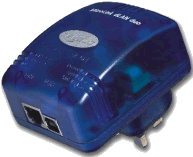ZM15 asked this interesting question just before Christmas over on Superuser. It came over to Security Stack Exchange for some security specific input and I was delighted to see it, as I have done a fair bit of work in the practical elements of securing communications – so this blog post may be a tad biased towards my experiences.
For those not in the know, Powerline ethernet is a technology which allows you to transmit ethernet over your existing mains wiring – which is very useful for buildings which aren’t suitable for running cabling, as all you need to do is pop one of these where you want to connect a computer or other ethernet enabled device and they will be able to route TCP/IP packets. There are some caveats of course, the signal really only works on a single phase, so if you have multiple phases in your house the signal may not travel from one to another, although as DBasnett commented, to get around this, commercial properties may inject the signal deliberately onto all phases.
 Early Powerline adapters had very poor signal quality – noise on the mains caused many problems – but since then the technology has improved considerably, partly through increasing the signal strength, but also through improving the filters which allow you to separate signal from mains.
Early Powerline adapters had very poor signal quality – noise on the mains caused many problems – but since then the technology has improved considerably, partly through increasing the signal strength, but also through improving the filters which allow you to separate signal from mains.
This is where the security problem lies – that signal can travel quite far down wires, and despite fuse boxes offering some resistance to signals, you can often find the signal is retrievable in the neighbour’s house. Damien answered:
I have experienced the signal bleed from my next door neighbor. I … could identify two other powerline adapters using the same network name. I got anywhere between 10 to 20Mbps of throughput between their adapters and mine. I was able to access their router, watch streaming video and see the computers on the network. I also noticed they had gotten IPs on my router also.
This prompted him to enable security.
Tylerl gave an excellent viewpoint, which is as accurate here as it has ever been:
Many of the more expensive network security disasters in IT have come from the assumption that “behind the firewall” everything is safe.
Here the assumption was that the perimeter of the house is a barrier, but it really isn’t.
Along even weirder lines, as is the way with any electrical signal, it will be transmitted to some degree from every wire that carries it, so if you have the right equipment you may be able to pick up the traffic from a vehicle parked on the street. This has long been an issue for organisations dealing in highly sensitive information, so various techniques have been developed to shield against these transmissions, however you are unlikely to have a Faraday cage built into your house. (See the article on TEMPEST over on Wikipedia or this 1972 NSA document for more information)
For similar wireless eavesdropping, read about keyboards, securing physical locations, this answer from Tom Leek and this one from Rook – all pointing out that to a determined attacker, there is not a lot the average person can do to protect themselves.
Scared yet?
Well, unless you have attackers specifically targeting you, you shouldn’t be, as it is very straightforward to enable security that would be appropriate for most individuals, at least for the foreseeable future. TEMPEST shielding should not be necessary and if you do run Powerline ethernet:
Most Powerline adapters have a security option – simply encryption using a shared key. It adds a little overhead to each communication, but as you can now get 1Gb adapters, this shouldn’t affect most of us. If you need >1Gb, get your property wired.
Liked this question of the week? Have questions of a security nature of your own? Security expert and want to help others? Come and join us at security.stackexchange.com.
